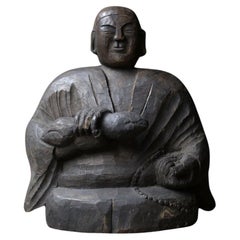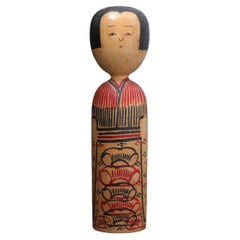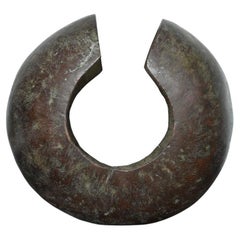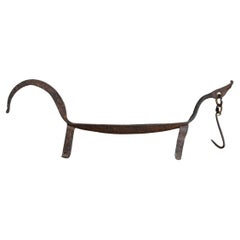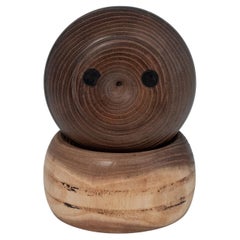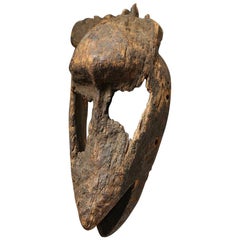Brood Sculptures and Carvings
to
4
1
3
1
1
2
2
1
1
1
2
2
2
2
2
4
4
4
Antique Wooden Sculpture "Kobo Daishi" / Buddha Statues / Edo-Meiji Period
Located in Sammu-shi, Chiba
This is an old Japanese "Kobo Daishi" wooden figure.
"Kobo Daishi" means "Kukai".
"Kukai" was a monk from the early Heian period. His posthumous name was "Kobo Daishi". He is the fou...
Category
Antique 19th Century Japanese Edo Sculptures and Carvings
Materials
Cypress
Large Kokeshi by Kyutaro Ogura
Located in Sammu-shi, Chiba
Vintage Large "Kokeshi" by Kyutaro Ogura. This large size is very rare. With signature.
Kyutaro Ogura (Ogura Kyutaro: 1906-1998)
Master: Hisashiro Ogur...
Category
Vintage 1980s Japanese Japonisme Scholar's Objects
Materials
Maple
Old Copper Coins of Congo, Africa / Rare Objects / Folk Art/20th century
Located in Sammu-shi, Chiba
This is an old African coin.
Before paper money and money were in circulation, bartering was taking place in Africa.
Various goods such as textiles, fea...
Category
20th Century Congolese Other Tribal Art
Materials
Copper
20th Century-African, Iron Object Made by the Lobi Tribe of Burkina Faso, Africa
Located in Sammu-shi, Chiba
An iron figurine made in Africa around the 20th century.
In many countries in Africa, iron objects are used for objects, coins, tools, and rituals.
Dogo...
Category
20th Century Burkinabe Tribal Tribal Art
Materials
Iron
Related Items
Modern Creative Kokeshi Doll by Hideo Ishihara, Japan
Located in Point Richmond, CA
Rare Modern creative Kokeshi doll by Hideo Ishihara, Japan
This rare whimsical sosaku kokeshi was created and signed by the award winning master, Hid...
Category
Mid-20th Century Japanese Mid-Century Modern Sculptures and Carvings
Materials
Wood
Weathered Archaic Bambara Wood Mask Fragment, Mali, Africa, Early 20th C.
Located in Point Richmond, CA
Add a piece of African history to your home. This is large and evocative of ancient times and ceremonies. Weathered wood mask fragment, Bambara people, Mali, Africa, late 19th-early ...
Category
Early 20th Century Malian Tribal Tribal Art
Materials
Wood
$1,795
H 14.75 in W 7 in D 5.5 in
Large Zitan Huanghuali Hardwood Brush Pot Bitong, Qing Dynasty, China
Located in Brooklyn, NY
Large Zitan Huanghuali hardwood brush pot bitong, Qing Dynasty, 18th century, China
Measures: Height 12 diameter 12.75 in.
Category
Antique 18th Century Chinese Qing Scholar's Objects
Materials
Zitan
Japanese Meiji Han Koto with Maki-e Lacquer Decoration
Located in Atlanta, GA
A rare Japanese Koto made from carved Paulownia wood and lavishly decorated with lacquer Maki-e circa late 19th century of Meiji Period (1868-1912). The ...
Category
Antique Late 19th Century Japanese Japonisme Lacquer
Materials
Wood
Bronze Currency Bracelet/Manilla, Dogon People, Burkina Faso, 19th Century
Located in Aramits, Nouvelle-Aquitaine
19th-century bronze currency bracelet / Manilla in horseshoe form with fixed opening. Intricate graphical swirl design and tips are shaped with large flat ends with 5 beads on each s...
Category
Antique Mid-19th Century Burkinabe Tribal Tribal Art
Materials
Brass
$891
H 1.38 in W 3.27 in D 3 in
Japanese Glazed Ceramic and Silver Koro Incense Burner Makuzu Kozan
By Makuzu Kozan
Located in Atlanta, GA
A tri-pod ceramic incense burner (koro) by Japanese Imperial potter Makuzu Kozan (1842-1916) circa late Meiji to the start of Taisho period (1890-1910s). A fine example of the artist's work belonging to the late part of his underglaze paint phase (started around 1887 until his death), the surface of the koro was painted in beautiful shades of blue to depict a continuous landscape not unlike a traditional ink and watercolor hand scroll. The rise and fall mountains recede and fade into the horizon and are dotted with groves of pines. The sky is painted with a beautiful subtle shade of pink, suggesting a time of sunrise or sunset. The koro is fitted with an ensuite reticulated sterling silver hoya (incense cover), pierced with swirling cloud and marked with "pure silver' in Kanji. The base is signed in underglaze blue "Makuzu Kozan Sei" within a double ring. The piece is beautifully potted in form and the decoration was done with expertise using the novel technique developed by Kozan called Fuki-e (the blow painting), in order to achieve the striking landscape known as "Mountain and Water" with sense of dimensions and gradient, the poetic effects normally conveyed only by sumi ink staining on paper. The piece comes with an unsigned tomobako (wood storage box) of a recent age.
Also known as Miyagawa Kozan (1842–1916), Makuzu Kozan was one of the most established and collected ceramist from Meiji Period. Born as Miyagawa Toranosuke, Kozan established his pottery studio in Yokohama around 1870s and later became one of the appointed artists to the Japanese Imperial household. His work was exhibited in many international fairs that the Meiji government participated at the turn of the century and won many grand prizes. Being one of the most creative ceramists, Kozan started experimenting with new chemical colors from the West in the format of his porcelain glaze around 1880s. New colors allowed him to create underglaze designs that appeared bright, smooth and glossy. He even invented his own receipt of cobalt blue to achieve a much brighter yet softer shade, as evident on this vase. To create landscape that is realistic and dimensional, more common in the western paintings, he was inspired by the native Japanese ink painting technique developed around 1900 by Yokoyama...
Category
Antique Early 1900s Japanese Japonisme Ceramics
Materials
Silver
Seated Laughing Jolly Bronze Buddha Sculpture, 18th-19th Century
Located in Studio City, CA
A wonderful, gem of a piece. The piece has a beautiful feel and heft to it. The laughing or jolly Buddha is known in China as Budai or Putai, Bodai in Vie...
Category
Antique 19th Century Asian Sculptures and Carvings
Materials
Bronze
Japanese Lacquer Tray with Maki-e and Inlay Hara Yoyusai Edo Period
Located in Atlanta, GA
A lovely Japanese lacquer rectangular lacquer tray with a slightly scalloped corner and four L shape supporting feet by one of the most celebrated lacquer artist active in Edo period Hara Yoyusai (1772-1845). Yoyusai lived in Edo (Tokyo) and worked under the patronage of Lord Matsudaira. He operated a large workshop and had a very prolific output of lacquer objects. Most survived pieces being inro...
Category
Antique 19th Century Japanese Japonisme Lacquer
Materials
Wood, Lacquer
$8,000
H 1.5 in W 11.5 in D 8.25 in
Striking Makonde Animal Helmet Mask, Dog or Hyena, Tanzania, Early 20th C.
Located in Point Richmond, CA
Striking Makonde animal helmet mask, dog or hyena, Tanzania. Early 20th century with dark patina from traditional tribal use, wear inside from being used. Finely carved features, wit...
Category
Early 20th Century Tanzanian Tribal Sculptures and Carvings
Materials
Wood
$1,400 Sale Price
20% Off
H 10.5 in W 8 in D 10.5 in
The Snaked Altar Column Statue Compressed Marble Powder Sculpture Bergama Museum
By LAGU
Located in İSTANBUL, TR
Weight: 8 kg
The Snaked Altar, situated atop a marble column at the entrance square of the Ancient City of Asclepion, holds the distinction of being recognized as the earliest symbol of medicine and pharmacy.
The altar's prominent position within the Asclepion complex highlights its importance in the context of ancient medical practices. It served as a visual representation of the profound connection between spirituality and healing, as Asclepius, the Greek god of medicine, was often depicted alongside snakes, which were regarded as symbols of rebirth and rejuvenation.
Today, the original Snaked Altar finds its rightful place of honor in the prestigious Bergama Museum. Visitors to the museum can marvel at its intricate details and appreciate the craftsmanship of the ancient artisans who sculpted it. The altar's preservation allows us to delve into the depths of history and gain insights into the ancient world's understanding and reverence for medicine.
*Crafted from compressed marble powder.
*Manufactured using molds...
Category
21st Century and Contemporary Turkish Classical Greek Sculptures and Car...
Materials
Statuary Marble
$388 / item
H 11.23 in W 5.71 in D 5.71 in
Finely Carved Japanese Okimono on Stand
Located in Atlanta, GA
An antique Okimono (Japanese means artsy display ornament object) displayed on a small custom wood stand from Meiji Period circa early 2oth century. T...
Category
Early 20th Century Japanese Japonisme Sculptures and Carvings
Materials
Wood
20th Century African Songye Nkishi Kifwebe Figure, Democratic Republic of Congo
Located in London, GB
For sale is this wonderful vintage African hand-carved Kifwebe association Figure (or "N'kishi"), originating from the Songye people of the Democratic Republic of Congo (formerly the...
Category
Late 20th Century Congolese Tribal Tribal Art
Materials
Metal
$817
H 11.42 in W 2.76 in D 2.76 in
